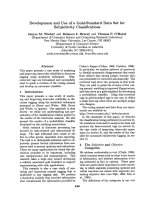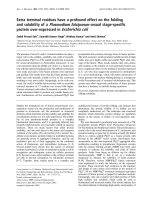The development and measurement of a customer satisfaction index (e CSI) in electronic banking
Bạn đang xem bản rút gọn của tài liệu. Xem và tải ngay bản đầy đủ của tài liệu tại đây (138.83 KB, 4 trang )
International Journal of Strategic Decision Sciences
Volume 8 • Issue 3 • July-September 2017
The Development and Measurement
of a Customer Satisfaction Index
(E-CSI) in Electronic Banking:
An Application to the Central Vietnam Region
Le Van Huy, Department of Marketing, University of Economics - The University of Danang, Danang, Vietnam
Pham Long, School of Management, College of Business & Social Sciences, University of Louisiana at Monroe, USA
Aidan O’Connor, ESCEM, Poitiers, France &Universität Osnabrück, Osnabrück, Germany
Pham Dinh Tuyen, University of Westminster, London, UK
ABSTRACT
In the current technological age, once traditional means of delivering services to customers are
losing its dominant position, the application of the Internet has evolved as an innovatively supporting
alternative for attracting customers, especially in banking service. In that aspect, customers’ perception
of online banking service through the delivery of website quality (Webqual) remains the main concern
for bank’s managers in Vietnamese banking system because customers are easily inclined to another
banking service provider due to their poor website-operated experience. Based on the evaluation of
factors influencing on banking website quality, its relationship to customer satisfaction and retention,
this article suggests the measurement of electronic Customer Satisfaction Index (e-CSI) of perceived
banking website quality by three most developed banks of Vietinbank, Vietcombank and BIDV in
central Vietnam, from which provides insights that may be useful for improving the quality of online
banking service.
KEywoRDS
Customer Satisfaction, e-CSI, Online Banking Service, Retention, Webqual
INTRoDUCTIoN
The availability and quality of the Internet and web applications have been significantly improved
over the last few years, which creates opportunities for commercial banks to extend their customer
and geographic base and acquire closer banker-customer networking relationships. In that respect,
Internet banking delivered via a website is prominent in promoting a customer relationship. Cao et
al., (2005) state that competitive advantages and other benefits due to the implementation of web
technology are obtained provided there is a quality and efficacious website.
Based on that premise, superior website service quality and efficacity serves as a connecting
factor for gaining and sustaining customers through experiencing the services provided and gradually
forming a sustainable relationship (Richardson & Thompson, 1997). Customer satisfaction indexes
(CSI) from many countries are analyzed because they prove to be an indicator of business operational
efficiency and market value (Anderson, Fornell & Rust, 1997).
DOI: 10.4018/IJSDS.2017070102
Copyright © 2017, IGI Global. Copying or distributing in print or electronic forms without written permission of IGI Global is prohibited.
45
International Journal of Strategic Decision Sciences
Volume 8 • Issue 3 • July-September 2017
The Vietnamese banking system has experienced a significant switch to electronic service
distribution channels and three of the most developed and pioneering banks of this type of service
channel are Vietcombank, Vietinbank and Bank for Investment and Development of Vietnam (BIDV).
The development of an electronic Customer Satisfaction Index (e-CSI) to measure the perception of
electronic service quality is the core issue for these banks and others in this segment of the Vietnamese
banking sector. Customers are easily displeased by the quality of specific services, especially services
through an electronic channel, and tend to switch to a competitor bank effortlessly, which requires
banks management to deal with the following issues: (1) identifying which factors affect customers’
perception of website quality service; (2) comparing their own CSI with those of competitors and
(3) prioritizing factors to improve customers’ commitment.
In the context of the reform of the banking sector, prior to and following, accession of Vietnam
to the WTO, the consequent direct entry of foreign banks, and the widespread introduction electronic
banking services this research proposes an innovative electronic Customer Satisfaction Index (e-CSI)
to be used as a reference for identifying the mode of customers’ behavior in the field of online
banking services. By comparing the set of three indexes of services offered by the leading banks
through an Internet -based service channel, this study recommends some recommendations for service
improvement and management initiatives.
THE RECENT DEVELoPMENT oF THE BANKING SECToR IN VIETNAM
The past ten years have seen the introduction of products, techniques and systems that have transformed
the banking sector. To analyse the customer satisfaction rating of Vietnamese banks’ electronic banking
services, it is necessary to put in context the evolution in the banking sector.
The transformation of the Vietnamese economy to a market economy commenced with reforms
in the mid-1980s. The ‘Doi Moi’ reforms produced economic growth in the late 1980s and early
1990s. However, the banking reforms were limited, merely separating commercial banking from
central banking, and as state-owned commercial banks emerged, they continued to be state managed.
The Government later considered that the banking sector should be completely reformed through
the equitization of domestic banks and through direct investment by foreign banks. It considered that
reforming the banking sector and allowing foreign banks to incorporate would lead to competition
and thereby development of the banking sector.
The opportunity was WTO accession. Besides allowing some foreign banks that had been
operating in Vietnam prior to WTO accession to incorporate there, following accession, the
Government allocated five licenses to foreign banks to incorporate in Vietnam. The five foreign
banks that were granted licenses are HSBC - United Kingdom, Standard Chartered Bank - United
Kingdom, ANZ Bank - Australia, Shinhan Bank - South Korea, and Hong Leong Bank - Malaysia.
These banks were obliged to modernise the banking sector, through products, technological processes
and management development.
Therefore, the recent development of the banking sector in Vietnam is partly due to the reforms
implemented prior to Vietnam’s accession in 2007to the WTO. However, the institutional reforms
implemented on accession to the WTO were the catalysts for banking sector development and for an
increase in the levels of monetization and financial deepening.1
THE RECENT DEVELoPMENT oF ELECTRoNIC BANKING IN VIETNAM
Jun and Cai (2001) define electronic banking (E-banking) as an electronic interconnection between
financial service providers and customers through ranges of distribution channels including POS/
ATM; online banking; mobile banking; and bank cards.
Essentially, the banking sector in Vietnam was relatively underdeveloped. In 2007, Vietnam had
a population of 85 million and less than 10% of the population had a bank account and of the eight
46
12 more pages are available in the full version of this
document, which may be purchased using the "Add to Cart"
button on the product's webpage:
www.igi-global.com/article/the-development-andmeasurement-of-a-customer-satisfaction-index-e-csi-inelectronic-banking/189077?camid=4v1
This title is available in InfoSci-Journals, InfoSci-Journal
Disciplines Business, Administration, and Management,
InfoSci-Knowledge Discovery, Information Management, and
Storage eJournal Collection, InfoSci-Management Science
and Organizational Research eJournal Collection, InfoSciOperations, Logistics, and Performance Assessment
eJournal Collection, InfoSci-Select. Recommend this product
to your librarian:
www.igi-global.com/e-resources/libraryrecommendation/?id=2
Related Content
Discrepancies and Analogies in Artificial Intelligence and Engineering Design
Approaches in Addressing Collaborative Decision-Making
Marija Jankovic and Pascale Zaraté (2011). International Journal of Decision Support
System Technology (pp. 1-14).
www.igi-global.com/article/discrepancies-analogies-artificial-intelligenceengineering/53812?camid=4v1a
De-Identification of Unstructured Textual Data using Artificial Immune
System for Privacy Preserving
Amine Rahmani, Abdelmalek Amine, Reda Mohamed Hamou, Mohamed Amine
Boudia and Hadj Ahmed Bouarara (2016). International Journal of Decision Support
System Technology (pp. 34-49).
www.igi-global.com/article/de-identification-of-unstructured-textual-datausing-artificial-immune-system-for-privacy-preserving/164440?camid=4v1a
New Forms of Work in the Light of Globalization in Software Development
Darja Smite and Juris Borzovs (2010). Infonomics for Distributed Business and
Decision-Making Environments: Creating Information System Ecology (pp. 277-287).
www.igi-global.com/chapter/new-forms-work-lightglobalization/38428?camid=4v1a
Information Management in a Grid-Based E-Health Business Environment: A
Technical-Business Analysis
Vassiliki Andronikou, Gabriel Sideras, Dimitrios Halkos, Michael Firopoulos and
Theodora Varvarigou (2010). Infonomics for Distributed Business and DecisionMaking Environments: Creating Information System Ecology (pp. 81-96).
www.igi-global.com/chapter/information-management-grid-basedhealth/38418?camid=4v1a









